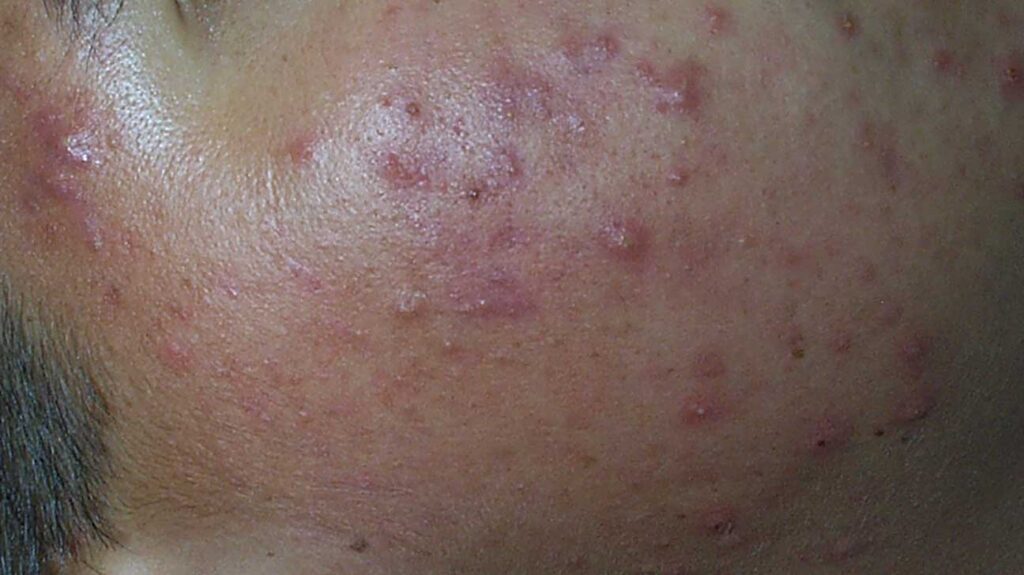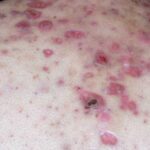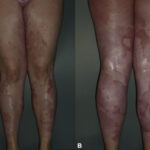Severe recalcitrant nodular rosacea represents a rare and complex manifestation of rosacea, marked by chronic inflammatory nodules that are unresponsive to standard treatment modalities. This condition often overlaps with phymatous changes and persistent erythema, significantly impairing skin integrity and patient quality of life. A comprehensive approach is necessary, combining clinical precision, targeted pharmacotherapy, and long-term management protocols.

Clinical Presentation and Distinctive Features
Key Characteristics
- Nodules and Papules: Firm, erythematous nodules localized predominantly on the central face.
- Persistent Erythema: Long-lasting facial redness with visible telangiectasia.
- Recalcitrance: Failure to respond to first-line therapies, including topical and oral agents.
- Phymatous Changes: Thickening of skin, often noted on the nose (rhinophyma).
- Flushing and Burning Sensation: Triggered by heat, alcohol, and certain foods.
Etiopathogenesis of Nodular Rosacea
Vascular Hyperreactivity
- Abnormal vasodilation contributes to persistent redness and flushing.
Inflammatory Cascade
- Dysregulation of innate immune responses leads to excessive production of cathelicidins and serine proteases.
Microbial Involvement
- Overproliferation of Demodex folliculorum and associated bacteria aggravates inflammatory response.
Skin Barrier Dysfunction
- Compromised epidermal barrier increases transepidermal water loss, heightening sensitivity and flare severity.
Diagnostic Criteria and Differential Diagnosis
Diagnostic Hallmarks
- Chronic centrofacial erythema with solid facial papules or nodules.
- Refractory to multiple treatment courses including antibiotics and metronidazole.
Differential Conditions
- Acne vulgaris: Comedones absent in rosacea.
- Lupus erythematosus: Confirmed via ANA and biopsy.
- Seborrheic dermatitis: Greasy scales and limited nodularity.
First-Line and Escalated Treatment Options
Topical Therapies (Limited Efficacy in Recalcitrant Cases)
- Metronidazole 0.75%/1%: Anti-inflammatory but often insufficient.
- Azelaic Acid 15% gel: Mild efficacy in papulopustular subtypes.
- Ivermectin 1% cream: Targets Demodex but limited penetration into nodular lesions.
Oral Antibiotics
- Tetracyclines (doxycycline, minocycline): Anti-inflammatory effects; suboptimal response in severe nodular variants.
- Macrolides: Alternative for patients intolerant to tetracyclines.
Systemic Retinoid Therapy: Isotretinoin
- Indicated for patients with severe, resistant nodular or phymatous rosacea.
- Dosage: 10–20 mg/day; may require prolonged low-dose therapy over 4–6 months.
- Mechanism: Reduces sebaceous gland activity, suppresses Demodex, and attenuates inflammatory response.
Monitoring Requirements
- Liver function tests, lipid panels, and pregnancy tests due to teratogenicity.
Adjunctive and Supportive Treatment Strategies
Vascular-Targeted Laser Therapy
- Pulsed-Dye Laser (PDL) and Intense Pulsed Light (IPL) effectively reduce erythema and telangiectasia.
Electrosurgery and CO₂ Laser
- Used for phymatous tissue reshaping and nodular debulking in late-stage rosacea.
Anti-Parasitic Approaches
- Oral ivermectin: Targets Demodex infestations contributing to persistent inflammation.
- Permethrin cream: Occasionally used in off-label regimens.
Biologic and Off-Label Options
- Investigational use of IL-17 inhibitors and botulinum toxin A has shown promise in reducing inflammation and facial flushing.
Chronic Management and Flare Prevention
Skin Barrier Restoration
- Use of ceramide-rich moisturizers and non-irritating cleansers to restore barrier function.
Trigger Avoidance
- Identification and avoidance of known triggers such as UV exposure, alcohol, spicy foods, and extreme temperatures.
Psychological Support
- Counseling and dermatologic patient education improve adherence and mental health outcomes in patients with visible skin disorders.
Prognosis and Long-Term Outlook
- Without intervention, nodular rosacea can progress to permanent tissue hypertrophy and fibrosis.
- With appropriate treatment, substantial lesion resolution and cosmetic improvement are achievable.
- Maintenance therapy is critical to sustain remission and prevent relapse.
FAQs
What defines recalcitrant nodular rosacea?
It is a rare form of rosacea with persistent nodules that do not respond to standard therapies like antibiotics or topical treatments.
Is isotretinoin effective for severe rosacea?
Yes. Low-dose isotretinoin is highly effective in resolving nodular lesions and reducing phymatous progression.
Can rosacea be cured?
No, but it can be effectively managed. Chronic suppression of symptoms and prevention of flare-ups are key goals.
Are lasers safe for rosacea patients?
Yes. Vascular lasers like PDL are considered safe and effective for erythema and visible vessels in rosacea.
What role does Demodex play in nodular rosacea?
Overproliferation of Demodex folliculorum triggers immune responses contributing to inflammation and nodule formation.

